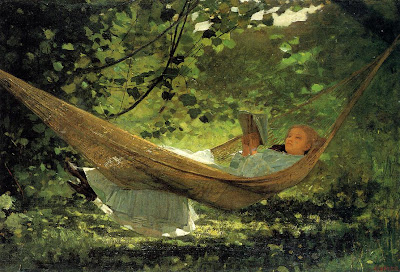Winslow Homer & the Element of Surprise
I had the great benefit of being able to study painting with a whole number of teachers when I started in art. Some of them were terrific at showing me new ways to see- I'm forever grateful to them. Each had their own way at conveying their insights. Sometimes the kernel of an idea could be boiled down to a single sentence. Like-
In a good painting everything fits together, especially the surprises the artist threw in.
The notion of surprise is a big one in art. Picasso touched on that with his famous saying that the role of art was to wash away from our lives the dust of everyday living. Life can be by turns stimulating or stultifying. Who wouldn't choose less of the latter. That's one of the reasons we have visual artists- people who have a knack for using their eyes and revealing some of the secretive surprises they discover. Think of it as adding visual spice to living.
This Winslow Homer (American, 1836-1910) painting above fits this advice perfectly (maybe he took the same class I did). If someone was telling you they were about to show you a painting of a woman lounging comfortably in a hammock wearing a long white dress and reading a book, think about the images you'd be likely to be calling up in your mind. It is a subject that has been hammered to death in the hands of less resourceful painters (for lessons in how not to paint I recommend going to the greeting card aisle in your local drug store).
Homer's oil plays against our expectations. He shows us things we'd overlooked, calling us back and saying "hey, don't miss this." And once you've seen them you're glad you didn't.
One of Homer's biggest challenges is to provide you with some drama of contrasting shapes. The long slow curve of the hammock needed something to move against it. He comes up with dramatically spotlighting just the bottom part of her dress that cascades over the hammock's edge to form a sort of triangular counterpoint to the hammock. I especially like the almost vertical highlighted edge of the dress that hangs the lowest in painting. We needed a surprise of major shapes moving against each other and Homer fills the bill right here.
Take a look at the woman's head. Nine out of ten painters would make the head the most detailed and sharpest form in a painting. It's their default setting. Homer says not so fast and proceeds to show us instead the short staccato accents of the dark pillow adjoining her neck on either side. They allow Homer to understate the face and at the same time push the whole head forward into our awareness. Imagine the whole right side of this painting without those two tiny spots of dark. It would be unforgivably dull and mushy instead of crisp and fresh.
If you look a long time at a good painting you keep discovering little new touches that take the piece to a higher level. It is like reading an engaging novel except just as you're nearing the end new chapters start appearing out of nowhere to take you father with the story. We could talk about those two dark branches in the upper left and how they echo (but not too much) the curves of our hammock. Or the amazing rhythm Homer sets up between a few selected individual leaves and the more generalized large clusters of foliage. When you're looking at a really good Homer your eyes are in the hands of a master.



